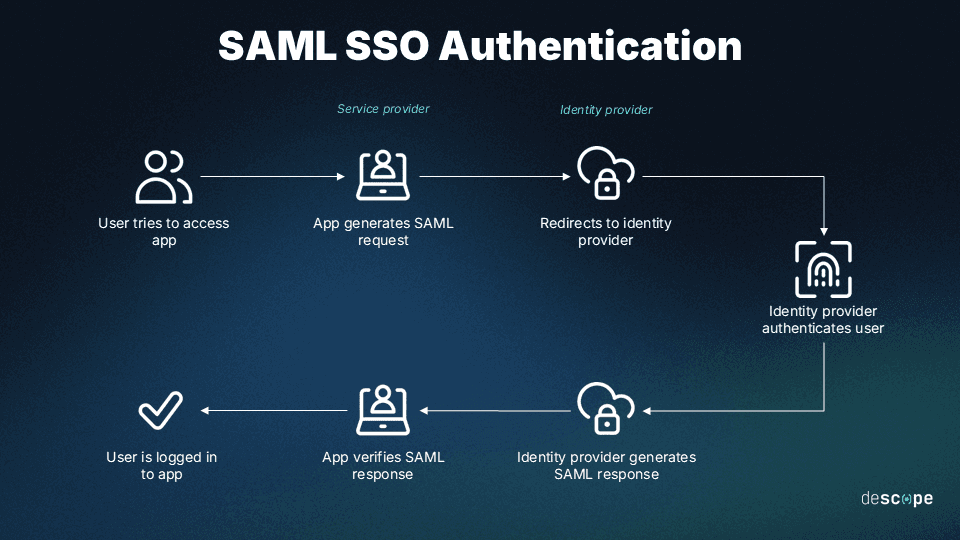Table of Contents
What is SSO?
If you're working with web applications or cloud-based services, you've likely come across the acronyms SAML and SSO. Both technologies are essential in managing user authentication and access control but differ in how they handle the process.
Comparing SAML and SSO can be confusing, as they’re closely related. Together, they offer a secure means for users to employ a single set of credentials to log in to multiple applications. Doing so simplifies the authentication experience, enhances security, and helps prevent account takeover.
In this article, we'll take a closer look at SAML vs. SSO to help you understand the differences and similarities between these two terms.
What is SSO?
Digital service providers (SP) often offer multiple related applications in their suites. For instance, they may have separate platforms for:
Email
Maps
Conferencing
Cloud storage
Video sharing
Web browsing
Calendar services
Single sign-on (SSO) is an authentication method that uses a singular set of credentials (like a username and password) to log in to all of these related services. If you’ve used Maps, Gmail and Drive with your singular Google account, you’ve already experienced the benefits of SSO.
When a user logs in to an app through an SSO entry point, their identity is verified across all related applications. Hence, they don’t need to re-enter their credentials to access other services. This allows employees to seamlessly bounce around an organization’s digital platforms and users to switch apps effortlessly.
To that end, SSO reduces the likelihood of account takeover. But that’s not its only benefit – fewer credentials also means fewer passwords for hackers to steal. This, in turn, leads to a more secure authentication process for users.
Looking to implement SSO for your app? Check out The Developer's Guide to Implementing Single Sign-On.
What is SAML?
SAML stands for Security Assertion Markup Language. It’s an Extensible Markup Language (XML) standard that facilitates secure authentication and authorization data exchange. XML standards function like rules in any other language, dictating how to make sense of things. In this case, SAML makes sense of packages of data.
SAML is like a secret code that allows SSO to work. It helps online services communicate with identity providers (IdP) to verify users’ credentials.
Essentially, most applications defer user authentication to a third-party IdP. But SAML provides the guidelines for the application's login interface to safely and intelligibly exchange information with the IdP. This means the user’s identity can be verified quickly and securely.
In other words, when you log in to an SSO system, SAML helps prove that you are who you say you are and that you’re allowed access to authorized websites and applications.

The difference between SAML and SSO
Since they’re both aspects of the same authentication process, it’s easy to confuse SAML and SSO. However, while they’re related, they’re not the same.
| SAML | SSO |
|---|---|---|
Purpose | SAML is the standard through which SPs and IdPs communicate with each other to verify credentials.
| SSO is an authentication process intended to simplify access to multiple applications with a single set of credentials. |
Features | SAML improves security by unburdening SPs from having to store login credentials. Instead, it places the responsibility on IdPs that specialize in such services. | SSO simplifies user experience (UX) by providing a singular access point for the multiple services and platforms users regularly access. |
Use cases | SAML simplifies and controls authentication-related tasks. It enforces secure login protocols and manages authentication permissions across various platforms. | SAML facilitates SSO, the primary use of which enables integrated logins across an organization’s multiple services. |
How SAML and SSO are related
SAML is one of the many standard protocols that can be used to power SSO authentication. While SSO logs users in to multiple accounts with a single set of credentials, SAML is one of the rulebooks that mediates how to authenticate such login requests.
Employing SSO facilitates simple user login for organizations, businesses, and developers seeking to deliver better UX across their digital services.
Implement SAML sans struggle with Descope
Poring over the intricacies of the SAML protocol can be complex and time-consuming. To keep logins simple and save time for your developers, give users a single authentication solution across all your platforms with Descope’s SAML-based SSO.

Descope’s visual workflow designer makes implementing SAML-based SSO authentication a breeze. With just a few lines of code, you can give users an all-encompassing login method replete with secure SAML communication, a trustworthy IdP, and customizable interface options.
Sign up for Descope to “descope” authentication from your daily work.






